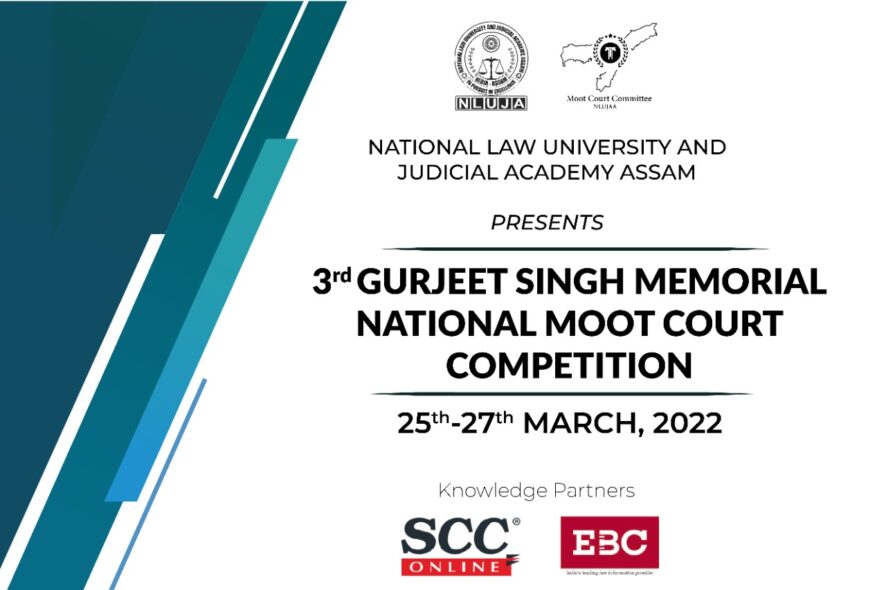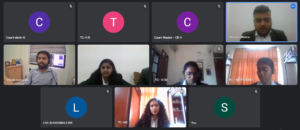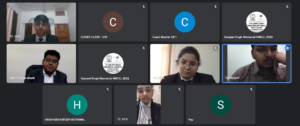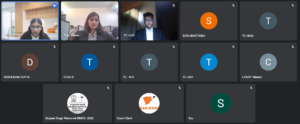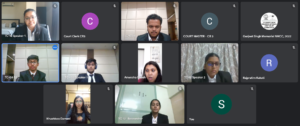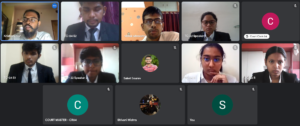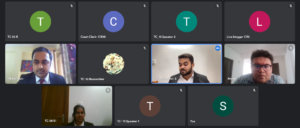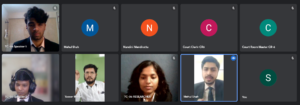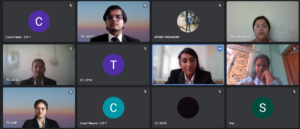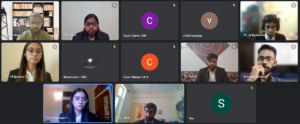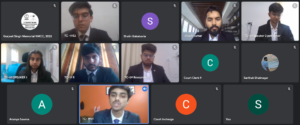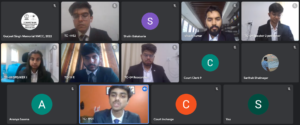Welcome to the 3rd Gurjeet Singh Memorial National Law Moot Court Competition, 2022 organized by National Law University, Assam!
About the Competition –
The Gurjeet Singh Singh Memorial Moot Court Competition has been organized by the National Law University and Judicial Academy, Assam, in memory of their beloved Founder- Vice Chancellor, Late Prof (Dr.) Gurjeet Singh who left for his heavenly abode on the 1st of April, 2017, out of indebtedness for his contribution and to symbolically immortalize his legacy in the annals of National Law University and Judicial Academy, Assam.
This year’s moot proposition revolves around the nuances of the Constitution designed primarily to foster the basic understanding of the principles of rule of law amongst all aspiring law students. It has been clubbed with the much contended provisions of the Unlawful Activities (Prevention) Act, 1967 and the Prevention of Money Laundering Act, 2002 which have received the limelight in recent times.
The moot problem for this edition has been drafted by Lavkesh Bhambani and Tushar Behl, who are Associates at L&L Partners.
The following teams registered and will be competing for the Winners Position:
- Amity Law School, Amity University Mumbai
- Amity Law School, Amity University Patna
- Apeejay Stya University
- Bangalore Institute of Legal Studies
- Central University of South Bihar
- Damodaram Sanjivayya National Law University
- Dr. Ram Manohar Lohiya National Law University
- Faculty of Law, Jamia Millia Islamia
- KIIT School of Law
- Kirit P Mehta School of Law, NMIMS, Mumbai
- Maharashtra National Law University, Nagpur
- MMM’s Shankarrao Chawan Law College, Pune
- Narsee Monjee Institute of Management and Sciences
- National Law Institute University
- School of Law, Christ (Deemed to be University)
- School of Law, Sastra (Deemed to be University)
- SVKM’s Pravin Gandhi College of Law
- Symbiosis Law School, Nagpur
- Symbiosis Law School, Pune
- VIT School of Law, Chennai
- UILS, Chandigarh University
- University Institute Of Legal Studies, Panjab University
DAY 1 (March 24) –
Inaugural Ceremony –
10:00 AM: The inauguration ceremony started. The Vice Chancellor, Prof. (Dr.) V. K. Ahuja addressed the gathering. He spoke about the recent achievements of the university in the field of Moot Court Competitions and International rankings. He spoke about the Indian Constitution and how fraternity is one of its important elements. At last he gave a few tips to the participants on how to argue before a court and wished them luck for the next two days. The Faculty Adviser for the Moot Court Committee at NLUJA, Prof. Ankur Madhia, and the Moot Court Committee Convener, Mr. Neil Madhav Goswami were also present.
19:00 PM: The draw of lots started.
DAY 2 (March 25) –
12:00 PM: The Researcher’s Test was conducted.
13:30 PM: The briefing of the judges took place and they were explained the Moot proposition in details.
14:00 PM: The 1st Preliminary Rounds started across 11 Courtrooms.
Preliminary Round 1 –
Court Room 1: In CR 1, the team from Maharashtra National Law University, Nagpur was facing the team from Dr. Ram Manohar Lohiya National Law University. As the Court Master was unavailable to contact the respondent team, the rounds commenced ex-parte. The petitioners argued maintainability before the Bench, which prompted the Bench to ask the counsel for the difference between PILs and Writs. The judges further asked the difference between a general and special legislation, and how a law made specifically for terrorists can be qualified.
Court Room 3: In CR 3, the team from Narsee Monjee Institute of Management and Sciences was up against the team from Symbiosis Law School, Nagpur. The petitioners argued against the twin conditions of bail under UAPA. The team faltered when asked to connect the facts of the precedent cited to the instant case. The respondents pleaded that Fundamental Rights can be curtailed by placing reasonable restrictions on the same in larger interests. They further argued that the presumption of innocence is not binding as PMLA is a special legislation.
Court Room 4: In CR 4, School of Law, Christ (Deemed to be University) was up against SVKM’s Pravin Gandhi College of Law. Counsel for the petitioner argues about the vagueness of reasonable justification present in the PMLA & UAPA further that Section 45 of PMLA should be tested with reasonable classification. Counsel for the respondent contends that the petition is not maintainable as the statutes were legislated for security of state and to prevent grave offense against state.
Court Room 7: In CR 7, School of Law, Sastra (Deemed to be University) was up against the team from MMM’s Shankarrao Chawan Law College, Pune. The petitioners argued about the principles of natural justice and how they were violated in the instant case. Respondents start with their arguments after a short break due to technical issues. They then defend the twin conditions under Section 45 of the PMLA.
Court Room 9: In CR 9, Damodaram Sanjivayya National Law University were against Faculty of Law, Jamia Millia Islamia. The Judge asks the petitioner about the reverse burden of proof to which the counsel answers easily. Counsel mentions several case laws to point out their arguments. The judges ask about the binding nature of UDHR and ICCPR and asks about any article in Constitution to state same in which the counsel failed to impress the judge by their answer. The counsel for the respondent pleads that the provisions of UAPA are not violative of Article 14 because of reasonable reasons and rational nexus. The judge asks about the facts of a case which they stated and its relevance to the case at hand to which the counsel easily answers.
DAY 3 (March 26) –
11:00 AM: The 2nd Preliminary Rounds started across 11 Courtrooms.
Preliminary Round 2 –
Court Room 2: In CR 2, University Institute Of Legal Studies, Panjab University faced Amity Law School, Amity University Patna. The Petitioners were asked by the judges to read their statement of jurisdiction. The judge also asked the petitioners to use the term “writ petition” instead of saying “instant suit”. The petitioners were also asked to define public injury. The Respondents argues that the twin conditions are in the furtherance of economy and that they are not arbitrary. They also argued that the provision works as a statutory injunction and stand valid as per procedure established by law.
Court Room 5: In CR 5, VIT School of Law, Chennai was challenging UILS, Chandigarh University. The petitioners were asked by the panel relate burden of proof with the right to self-incrimination. The speakers deferred their response to the same. Speaker further contended that Section 50(3) of PMLA compels the person to speak against their own self and is against Article 20(3). Panel asks the respondents’ counsel that if Section 19 of PMLA to states the safeguard, what exactly is the remedy if an accused is charged of perjury. The counsel’s answers were unsatisfactory for the judges and hence the questions continued further.
Court Room 6: In CR 6, the team from Amity Law School, Amity University was facing the team from Mumbai against KIIT School of Law. The petitioners didn’t join the courtroom even after a delay of 40 mins and were hence disqualified from the competition. The respondents, arguing ex-parte, submitted many issues. They were also reprimanded by the Judges for not knowing the fine differences between an ECIR and an FIR.
Court Room 8: In CR 8, we had Faculty of Law, Jamia Millia Islamia against going up against School of Law, Christ (Deemed to be University). The counsel for the petitioners began pleading before the Bench and agued the impugned bail provisions were manifestly arbitrary in nature. The respondents argued in favor of the twin conditions and they also talked about the objects and reasons of the PMLA.
Court Room 10: In CR 10, Dr. Ram Manohar Lohiya National Law University was facing Narsee Monjee Institute of Management and Sciences. The petitioners were not able to be contacted by the Organizing Committee and were hence disqualified from the proceedings. The respondents continued ex-parte. The Bench asked the counsels for the respondents to state the gist of Section 25 under Indian Evidence Act, and Section 50 of the PMLA. Interesting arguments were made on the difference between the powers of a police officer and a custom officer were presented.
Court Room 11: In CR 11, SVKM’s Pravin Gandhi College of Law was facing University Institute Of Legal Studies, Panjab University. Counsels for the petitioner argued against the constitutionality of the reverse burden of proof. The respondent side mentioned examples of reverse onus of proof citing some provisions of PMLA and UAPA; they also cited the Noor Aga case.
15:00 PM: The last Preliminary Rounds end across all Courtrooms.
Quarter Finals –
15:30 PM: The quarter finalists of the 3rd Edition of GSM NMCC are:
- Maharashtra National Law University, Nagpur
- School of Law, Sastra (Deemed to be University)
- Damodaram Sanjivayya National Law University
- UILS, Chandigarh University
- Symbiosis Law School, Nagpur
- Symbiosis Law School, Pune
- Faculty of Law, Jamia Millia Islamia
- SVKM’s Pravin Gandhi College of Law
15:40 PM: The draw of lots is taking place
15:45 PM: The fixtures for the Quarter Finals are as follows: (P v. R)
CR 1 – MNLU, Nagpur v. SLS, Nagpur
CR 2 – School of Law, Sastra (Deemed to be University) v. SVKM’s Pravin Gandhi College of Law
CR 3 – SLS, Pune v. DSNLU
CR 4 – Faculty of Law, Jamia Millia Islamia v. UILS, Chandigarh University
16:00 PM: The Quarter Finals commenced.
Court Room 1: The Petitioners in this room were repeatedly interjected by an interactive panel of Judges. The honorable judge highlights the distinction between PMLA and UAPA and asks why should this Act be struck down when TADA and POTA were not struck down having similar provisions; to which the counsel tries to illustrate their arguments but is not able to proceed due to an unconvinced panel. The honorable judges seeming to be dissatisfied, further emphasis is made on the point that why should the court grant bail, if the court is prima facie satisfied that the person is a terrorist. The counsel for the petitioner goes ahead in establishing his contention that every person should not be granted bail, but only the stringency and the rigidity of such provisions must be diluted. Coming to the respondents, they were asked that since under UAPA and PMLA ‘jail being the rule and bail being the exception’, to prove the innocence of the client, the undertrial would be condemned languishing in jail for years and years, how is the provision just and fair? However, the counsels for the respondent stayed silent at many moments and pleaded ignorance.
Court Room 2: After some controversy over the maintainability of the present petition, the counsels for the petitioner argued against the arbitrary nature of the reverse burden of proof. To this, the judges asked the Speaker to refer to a provision whereby it is shown that any provision was declared unconstitutional due to vagueness. Counsel for the petitioner cited the Shreya Singhal and Maneka Gandhi cases to satisfy the Bench. The respondents contended that officers under PMLA are not police officers. Issuing summons under Section 50(2) of the same is not violative of the Article 22 of the Constitution.
Court Room 3: In CR 3, the petitioners were asked that when exception with regards to the admissibility of statements while in custody is mentioned in Section 26 of the Indian Evidence Act then why can’t the PMLA make an exception? To which, counsel for the petitioner responds because the provision is in contravention of Fundamental Rights. The respondents were equally grilled with the Bench asking them how does the reverse burden of proof issue measure against innocent until proven guilty? The counsel for the respondent retorts that the notion of ‘innocent until proven guilty’ is a basic human right but not a fundamental right under the Constitution. Further, granting bail is on various grounds and the witnesses are not eligible as they are highly connected engineers who are very capable of tampering with the evidence.
Court Room 4: In CR 4, the petitioners, while speaking for the individual liberty of the accused, were posed with a pertinent question by the bench. The judges asked if individual liberty of accused could be placed above the national security. To which, the counsel replied in affirmative. The judges expressed their disagreement and said that in such a case bail should not be granted. The respondents representing the State came under fire for the misuse of UAPA in general. The counsels for the same tried to argue that there has been misuse of the legislation but that is not the present case. When the Bench contended that there are grounds for them to intervene, the counsel argued for the presumption of constitutionality in State actions and legislations.
20:00 PM: The Quarter Finals conclude across all Courtrooms. Results declared.
The Following teams have qualified for the Semi Final Rounds:
- MNLU, Nagpur
- SLS, Nagpur
- UILS, Chandigarh University
- Faculty of Law, Jamia Millia Islamia
DAY 4 (March 27) –
Semi Finals –
10:00 AM: The semi-final line ups are as follows:
CR 1 – Faculty of Law, Jamia Millia Islamia v. MNLU, Nagpur
CR 2 – SLS, Nagpur v. UILS, Chandigarh University
10:30 AM: The Semi Finals commence.
Court Room 1: The first semi-final was between Faculty of Law, Jamia Millia Islamia and MNLU, Nagpur. The Jindal Law School was representing the Petitioner and the Amity Law School was representing the Respondent. This round was judged by Mr. Subhash Chandra Keyal, Mr. Tejas Karia, and Ms. Aishwarya Bhati. Counsel for the Petitioners begins advancing his arguments tactfully. The judge interjects the counsel on the line and length of their arguments equating the provisions of PMLA with the NDPS Act, and whether the Counsel is trying to refer to both the acts as Para Materia in all respects. The Counsel responds in affirmative. The second Counsel for the petitioners continues to build on his argument on violation of fundamental rights citing a few precedents. The judge interjects and seeks clarification from the Counsel if they’re well-versed with the facts of Anwar Ali’s case. The respondents begin presenting the issue of maintainability before the bench. The counsel further argues that the twin legislation under UAPA are not unconstitutional. The same was substantiated by using Nikesh Tarachand Shah’s case. The judges asked the counsel to present the facts of the Tarachand Case, the Counsel however, failed to satisfy the judges.
Court Room 2: The matchup between SLS, Nagpur and UILS, Chandigarh University was a remarkable display of in-depth legal research. It was judged by a learned bench comprising of Ms. Sonia Mathur, Mr. Alok Sonker, and Mr. Pragyan Sharma. The Counsel for the Petitioners begins by proving their locus standi in the court. A series of questions regarding the issue of maintainability followed the counsel’s line of argument. The Second Counsel begins by citing a few precedents by High Court in order to prove that ED Officers can be considered as Police officers. The judges asked the counsel to cite Supreme Court cases to support their argument as High Court cases do not hold much authority. The Counsel further argues the Twin conditions of UAPA and the reverse burden of proof are violative of Fundamental Rights. The Counsel for Respondents begins by arguing that the petition would not be maintainable since the alternative remedy had been exhausted and the case had already been settled by the High Court. On the issue of right against self incrimination, the judges posed questions pertaining to Section 50 of PMLA and how it violates Article 20 (3) of the Constitution. The Counsel concludes by pleading that the reverse burden of proof does not violate the Fundamental Rights of the accused.
13:30 PM: The Semi Finals conclude, and the Finalists are announced. The finalists for the 3rd edition of GSM NMCC are:
- MNLU, Nagpur (P)
- UILS, Chandigarh University (R)
Finals –
14:00 PM: The Final rounds for the 3rd GSM NMCC 2022 begin.
The finals were judged by three distinguished sitting Justices of the Gauhati High Court, i.e. Hon’ble Mr. Justice N. Kotiswar Singh, Hon’ble Mrs. Justice Rumi Kumari Phukan, and Hon’ble Mr. Justice Manish Choudhury.
The Petitioners (TC 1 – MNLU, Nagpur)
Speaker 1
The first speaker from the Petitioner’s side first dealt with the crucial issue of maintainability. They cited the PUCL case to establish their locus standi in the instant case. He went on to argue that the reverse onus of proof that is prevailing in the instant case under UAPA and PMLA is ultra vires to the Constitution of India. He cited the M Nagaraj case under this issue to prove that the provisions of UAPA suffer from ambiguity and arbitrariness and are therefore invalid and unconstitutional. He added that the classification undertaken under the UAPA is not founded on intelligible differentia. The Judges asked the counsel to cite precedents relating to the reverse burden of proof, to which the counsel replied with the K. Veeraswami case. He additionally said that the pending backlog of cases under the UAPA proved how the Act was causing human rights violations across the country. All things considered, the first speaker seemed very confident of themselves and was able to satisfy the Bench with their arguments.
Speaker 2
The second speaker from the Petitioner’s side argued against the twin conditions under UAPA and PMLA. They added that the twin conditions are ultra vires of the Constitution being violative of fundamental rights such as those under Article 21. They relied on the Nikesh Tarachand Shah case to prove the same. When the Bench asked the counsel why the provisions under UAPA and PMLA have to be held as invalid and arbitrary when the same provisions under earlier statutes such as TADA and NDPS were not considered arbitrary, the counsel failed to produce a satisfactory response. Coming back to UAPA, referring to their prayer, the Judges asked the counsel why they prayed for them to strike down the impugned provisions and not simply read them down. To this, counsel replied that the scope for misinterpretation always exists in such legislations which grant such sweeping powers to the State. Counsel referred to examples of the journalists detained in Delhi to prove their argument.
The Respondents (TC 10 – UILS, Chandigarh University)
Speaker 1
The first respondent speaker tore into the maintainability of the petition in the instant case. They pleaded that not only were alternative remedies not exhausted by the petitioners, but also that there was no substantial basis for the same as no Fundamental Rights were violated without due process. Further, they added that the present petition does not qualify as a PIL as benefit from the same only accrues to the petitioners themselves, and not the society at large. The respondents’ second issue dealt with the violation of the Indian Evidence Act via Section 50 of the PMLA. To disprove the same, counsel relied upon the Shiv Moin case. The speaker ended by adding that both UAPA and PMLA lay down valid procedures which are important for national integrity. The judges seemed satisfied with the first counsel’s arguments.
Speaker 2
The second counsel began by arguing that Fundamental Rights under Articles 14 and 21 have been very well upheld by the State in the instant case. They moved on the second issue which dealt with the special twin conditions. Replying to the petitioners’ arguments, the counsel posited that reliance on the Nikesh Tarachand case is untenable as it has been substituted post 2013, and the post amendment scenario is wholly different. They contended that removing infirmity in earlier legislation implies no arbitrariness via reliance on several key precedents. On the issue of why bail could not be granted in the instant case, counsel added that serious economic offences had been committed by the accused and bail could lead to serious evidence tampering and therefore miscarriage of justice. By reading the Preamble of UAPA and PMLA, the counsel tried to prove that under Section 45 of PMLA and Section 43 of UAPA, there was a clear presence of intelligible differentia. The Bench’s critical contention with the counsel was on the issue of the reverse burden of proof, and they inquired from the counsel that at what stage would the same start operating. To this, the counsel replied that when the prima facie case has been made the reverse burden of proof would start operating in such cases, which did not seem to impress the Judges.
16:00 PM: The Final round concludes.
The Valedictory Ceremony –
17:00 PM: The ceremony begins in the august presence of Hon’ble Mr. Justice N. Kotiswar Singh, Hon’ble Mrs. Justice Rumi Kumari Phukan, Hon’ble Mr. Justice Manish Choudhury, Prof. (Dr.) V. K. Ahuja, the MCC Convener Mr. Neil Madhav Goswami, and the student fraternity of NLUJA along with the participants.
17:05 PM: Hon’ble Vice Chancellor Sir felicitates the Chief Guests for the occasion.
17:10 PM: Vice-Chancellor’s address begins. Prof. (Dr.) V. K. Ahuja speaks about the Justices sparing the valuable time on a Sunday to come and grace the ceremony and also adjudge the Finals of the prestigious 3rd edition of the NLUJA GSM NMCC 2022. He also adds that everyone who participates in such co-curriculars is already a winner.
17:14 PM: Hon’ble Mr. Justice N. Kotiswar Singh’s address begins. He speaks of the importance of grassroot level lawyers and the importance of passion in this profession. He laments the gradual decline in the standard of lawyers. He ends on a note of hope urging young students to earn the confidence of the Court and start at the District level; he says that there is nothing compared to the thrill and independence of being a lawyer.
17:31 PM: Hon’ble Mrs. Justice Rumi Kumari Phukan’s address begins. She comments on the novelty of an experience such as the moot court and how it is her first encounter with the same. She adds it was an enriching experience and congratulates the excellent speakers. She also spoke of the importance of duty of lawyers to their clients.
17:37 PM: Hon’ble Mr. Justice Manish Choudhury’s address begins. Sir agrees with the previous speakers and only adds that the issues and topics discussed in the moot proposition are all issues that are highly relevant in these times and deserve a lot of discourse and discussion around them.
17:40 PM: Declaration of results begins.
The Winners:
Best Memorial: SLS, Nagpur
Best Researcher: Vrinda Jain – MNLU, Nagpur
Best Speaker: Shabbir Ahmed – Faculty of Law, Jamia Millia Islamia
Best Team: MNLU, Nagpur
Runners Up: UILS, Chandigarh University
17:45 PM: Vote of thanks by the Moot Court Committee Convener, NLUJA.



